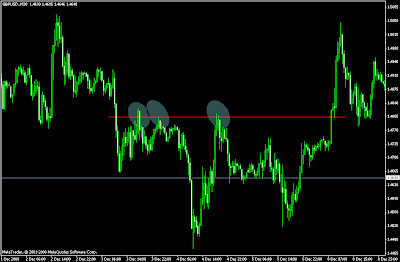HOW TO APPLY SUPPORT/RESISTANCE AS SIMPLE TRADING STRATEGY [BAGIAN 2]
>> Selasa, 30 Desember 2008
APLIKASI SUPPORT DAN RESISTANCE SEBAGAI SEBUAH STRATEGI?
Setelah memahami apa itu support dan resistance tentunya rekan rekan trader mendapatkan sebuah gambar bagaimana bertrading dengan menggunakan support dan resistance. Ya tepat sekali kita bertrading dengan cara fading, counter trend, melawan trend, meletakan order kita (limit order) pada level dan berharap harga berbalik.
Sekarang kita coba ingat prinsip dasar Analisis Teknikal ‘until the weight of evidence proves and shows the trend has been reversed’…filosofi yang seharusnya terus dipegang oleh kita, don’t fight the market, be friend with the trend until it bend. wah kontradiktif dong dengan prinsip entry berdasar S/R?.Nah oleh karena itulah dalam hal ini kita harus belajar dan memahami perilaku gelombang harga sebelum mengaplikasikan support dan resistance sebagai trading strategi kita.
MENGENALI SIFAT SUPPORT DAN RESISTANCE
1. Sebuah level support dan resistance (S/R) akan bekerja dengan baik apabila pada waktu sebelumnya telah berperan baik dengan menahan laju gerak harga, dalam hal ini paling tidak kita mencari 2 kali peristiwa di mana level tersebut bekerja.
2. Sebuah level S/R yang tertembus/terbreak akan bertukar peran, support menjadi resistance, resistance menjadi support.
MEMAHAMI TREND, RETRACEMENT
Apa itu trend?
Markets have three trends, an uptrend (trend 1) as a time when successive rallies in a security price close at levels higher than those achieved in previous rallies and when lows occur at levels higher than previous lows. Downtrends (trend 2) occur when markets make lower lows and lower highs. It is this concept of Dow Theory that provides the basis of technical analysis definition of a price trend. Dow described what he saw as a recurring theme in the market: Prices would move sharply in one direction, recede briefly in the opposite direction, and then continue in their original direction (trend 3).
Menurut cuplikan Dow theory di atas trend terjadi ketika kita harga yang bergerak berkesinambungan membentuk higher low (dalam uptrend) atau lower high (dalam downtrend). Ini berarti bahwa dalam sebuah trend, harga tidak bergerak dalam sebuah garis lurus yang tajam melainkan bergerak dalam prinsip gelombang (gerakan naik dan turun terjadi berulang ulang). Dan prinsip inilah yang akan kita manfaatkan dalam trading strategi yang akan kita gunakan.
Retracement?
Harga tidak bergerak dalam satu garis lurus yang tajam, melainkan dalam gelombang yang bergerak naik dan turun. Gerakan melawan arah trend yang diikuti dengan terbentuknya higher low atau lower high itulah yang akan kita kenal sebagai retracement.
bersambung ...




